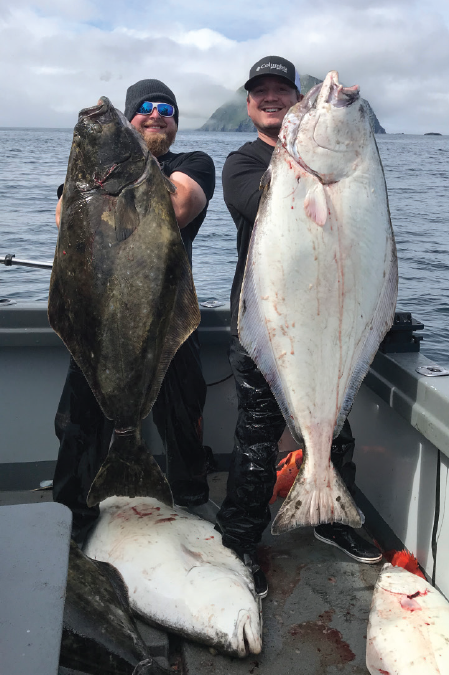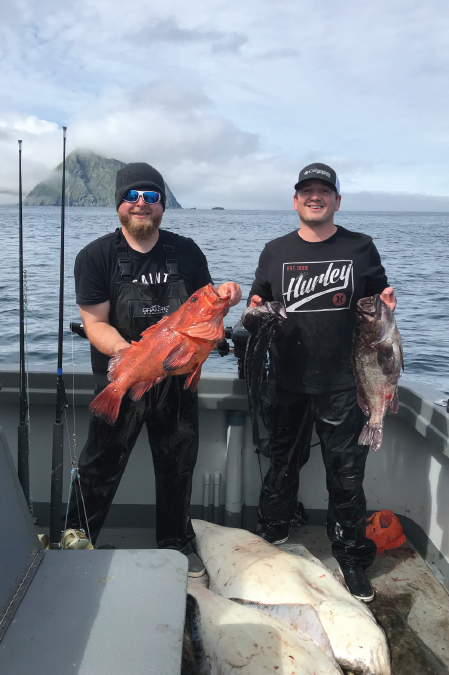When planning out your first trip to Alaska to go on a bucket list fishing expedition, you don’t expect to battle a worldwide pandemic in the process. We had planned the trip, bought our tickets and requested time off work well before the pandemic hit — but even after the novel virus came into existence, we were determined to rip some lips and spend a week in the last frontier.
Luckily for me, the process wasn’t too difficult and I was going with a resilient group of anglers: my best friend John, his brother Alex, Alex’s wife Karly and their mother Carol. We rented out an entire boat to ourselves through the O’fish’ial Charters of Alaska and planned out two full days of fishing through their website, www.bighalibut.com. The first day we planned was a halibut and salmon combo where we could catch up to two halibut and six salmon, and the second day was for trophy halibut and rockfish. We were obviously excited to go fishing both days, but it seemed like what we talked about most was the trophy halibut and how big our catches would be. The largest halibut ever recorded weighed in at a staggering 459 pounds and was caught in Alaska.

Our second day in Alaska was spent driving the 186 miles from Girdwood to Homer, which is known as the halibut capital of the world. Once in Homer, we unpacked the truck and got all of our gear prepped for our first day of fishing the next morning. That evening was spent discussing our excitement of getting out on the water and meeting the captain. While eating dinner we made bets on who would catch the first fish and the biggest fish of the trip. After all the bets were placed, we were off to bed to get a good night’s rest for our full day of angling.
The morning of our first day of fishing, you could feel the excitement in the air. The group was giddy as we packed our lunch and put on our waterproof jackets. We drove down the Homer Spit, a 4.5-mile stretch of land that juts out into Kachemak Bay. Off of the spit is where all the different fishing charters have their businesses, and just down the road from them is the Homer Boat Harbor. We met up with our captain Corey and his deckhand Austin — who coincidentally was from Merced — then boarded the 34-foot, 10 passenger catamaran called a Katilak and made our way out of the harbor.

Since halibut would be the harder fish for us to catch, we started our morning dropping our deep sea rods down first. The halibut like to sit on the bottom of the ocean floor, so depending on our location we would drop our lines rigged with squid down 80 to 120 feet. It didn’t take long for the fish to start biting once we dropped in our lines.
Carol was the first of our group to catch a halibut. The excitement and joy she showed while reeling up that first catch motivated the whole boat. Like every fishing trip, you never know if or when you’ll catch something, but the moment you hook onto something it changes the whole atmosphere. Soon, everyone was pulling up halibut.
In Alaska, you're allowed a limit of two halibut a day. One halibut can be any size, but the second has to be under 28 inches. As we pulled in our catches, it was a guessing game of, “How many inches is this fish, and can I catch a bigger one?”
We wanted to reel in the biggest halibut we could, but we also didn’t want to throw a fish back and then take that chance of not being to reel another fish in. It was difficult hauling in these gorgeous fish and trying to determine whether or not we wanted to keep them, because we knew halibut can grow to monstrous sizes. When we reeled in a 24-inch halibut, which in California would be considered a great catch, the captain and deckhand laughed them off as if they were guppies.

Now that we had caught our limit on halibut for the day, we were ready to switch to salmon fishing. We changed over to a lighter rod and threw out a couple jigs into the water. Immediately, we started hitting some pink and silver salmon. Captain Corey had put us right on top of a school and they were breaching top water trying to hit our jigs before they even had a chance to sink five feet down. It was one of the coolest experiences I’ve ever had while fishing. Even our deckhand Austin explained to us that it was a pretty rare sight to see a giant school hit on the top water like that. We had a limit of six salmon each, and we were pulling them out left and right it seemed. But, many of the salmon were your standard pinks and cohos or silvers.
What we really wanted is what they call “royalty” in Alaska: some king or Chinook salmon. We switched our location and threw out the down riggers in hopes of hitting some bigger fish deeper down. Soon, our rods were bending like crazy and Corey had us on top of a school of Chinook. The amount of fight they had compared to the silvers and pinks was astonishing. Our boat couldn’t keep up with how many fish we were landing. It felt like a matter of minutes before our whole crew had caught their limit on salmon as well. With a boat full of fish and a happy crew, we made our way back to the Homer Spit.
That night we were all in good spirits as we dreamt about catching our limits and the trophy halibut we would be going for the next day. The next morning it seemed we were even more anxious to get out due to our success the previous morning. As we got ready to head out the second morning, our deckhand explained that since we were going for trophy halibut, we would have to venture out further to a location called the Barren Islands. It was about a two-and-a-half-hour boat ride and once we got into place, we were ready to drop our deep sea rods once more and begin our hunt for some monster halibut.

We patiently sat with our poles in the water when I felt a huge jolt in my hands and the pole took a major lunge. I heard everyone screaming “fish on” as I jumped awake and started to reel in my catch. Upon reeling in, I could feel right away that I had a giant on the end of my line. I could only reel in an inch or two at a time until the fish on the other end would send the line screaming out another 50 feet.
As I struggled to bring in my catch, Alex came alive next to me as his rod started to bend. There we stood side-by-side, each of us breathing heavily to bring up our lines. Every turn of the handle felt like a workout. The end of the pole dug into my side and I used all of my strength to only gain an inch or two. As Alex and I fought, we had our whole crew cheering us on. I could hear John’s words of encouragement (“You got this bro, steady.”) and the captain’s instructions (“Okay Seth, easy, easy, just walk her back.”) as I brought the halibut closer and closer to the back of the boat.
I fought for a good 20 minutes before we could see any color rise to the surface of the water. Once we saw the fish’s color, I was bombarded with seemingly one hundred different instructions: “Walk her back slowly,” “Don’t let it breach the water,” “Keep the tip down,” “Reel, reel, reel!”
There was a flood of adrenaline that went through me and I felt like I was doing everything in my power just to keep the fish on the line. When it got near the back of the boat, it was fighting so hard that the captain had to go to the cabin in the boat and get his .410 shotgun. Once the behemoth was next to the boat, a single slug to the middle of head and a few gaff hooks allowed them to haul the 55-inch, 95-pound monstrosity into the boat. The relief of seeing the halibut in the boat thrashing around and the shouts of joy from the whole crew made the struggle and workout well worth the trip.

My one piece of advice for anyone planning a trip to go big game fishing in Alaska — or anywhere else — is to plan on how you’re going to process your fish and send it home. This was all of our first time going and we didn’t really know too much about this process. When you catch your fish, you’ll need someone to clean and process your fish to be eaten. If you're planning on traveling back home with it, you have two options: have the processors pack your fish up and give it back to you so you can fly home with it, or have them FedEx it straight to your home.
I was nervous about flying home with 85 pounds of dressed meat because we had a long trip back, so I paid $1,000 to get my fish delivered overnight. John took the risk and paid the $200 to fly home with his, and his fish was still perfectly frozen upon landing. In the future, I will be flying home with anything I catch and I advise anyone that doesn’t have over a 12-hour trip home to do the same in order to save yourself a lot of money.
As we basked in our glory of catching our limits in halibut and rockfish, we all couldn’t help but fall in love with Alaska. It's easy to see why they call it the last frontier. During our five-day trip in Alaska we saw a moose, packs of orcas swimming next to our boat, puffins and countless bald eagles, along with some of the most beautiful mountain ranges and glaciers. On our way back to the Homer Spit we all talked about how we couldn’t wait to return to Alaska and do more sightseeing and fishing. If you ever catch yourself in Homer, make sure to stop off the Salty Dawg Saloon and grab yourself a drink to celebrate your catches.





